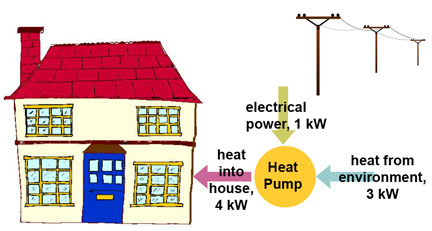Coefficient of Performance, COP
The COP is a measure of the amount of power input to a system compared to the amount of power output by that system:[2]

The
COP is therefore a measurement of efficiency; the higher the number,
the more efficient the system is. The COP is dimensionless because the
input power and output power are measured in Watt. The COP is also an
instantaneous measurement in that the units are power which can be
measured at one point in time.
Consider a simple electric heater. All of the electricity that is input to the unit is converted to heat. There is no waste and the power output (in heat) equals the power input (in electricity), so the COP is one. The COP can be used to describe any system, not just heating and cooling.
An air conditioning system uses power to move heat from one place to another place. When cooling, the air conditioning system is moving heat from the space being cooled (usually a room), to somewhere it is unwanted (usually outside). A heat pump uses the same principles, but it is moving heat from outside (the cold side) to the space being heated inside (the living space).
The maximum theoretical COP for an air conditioning system is expressed by Carnot’s theorem, reduced to the following equation:

Consider a simple electric heater. All of the electricity that is input to the unit is converted to heat. There is no waste and the power output (in heat) equals the power input (in electricity), so the COP is one. The COP can be used to describe any system, not just heating and cooling.
An air conditioning system uses power to move heat from one place to another place. When cooling, the air conditioning system is moving heat from the space being cooled (usually a room), to somewhere it is unwanted (usually outside). A heat pump uses the same principles, but it is moving heat from outside (the cold side) to the space being heated inside (the living space).
The maximum theoretical COP for an air conditioning system is expressed by Carnot’s theorem, reduced to the following equation:

Where
TC is the cold temperature and TH is the hot temperature. For space
cooling, the cold temperature is inside the space; for space heating,
the cold temperature is outside. All temperatures are expressed in
Kelvin. To convert from °C to Kelvin, add 273.15. To convert from °F to
°C, subtract 32, multiply by 5 and divide by 9.
As you can see from equation 2, as the difference between the hot temperature and the cold temperature increases, the COP becomes lower, and vice versa. This means that an air conditioning system is more efficient when the room temperature is closer to the outside temperature and will use more power when there is a larger difference in these temperatures.
As an example, consider the maximum theoretical efficiency of an air conditioning system that is cooling a room to 23°C (73.4°F). If the outside air temperature is 32°C (89.6°F), the theoretical maximum efficiency is:
As you can see from equation 2, as the difference between the hot temperature and the cold temperature increases, the COP becomes lower, and vice versa. This means that an air conditioning system is more efficient when the room temperature is closer to the outside temperature and will use more power when there is a larger difference in these temperatures.
As an example, consider the maximum theoretical efficiency of an air conditioning system that is cooling a room to 23°C (73.4°F). If the outside air temperature is 32°C (89.6°F), the theoretical maximum efficiency is:

Typical
COP values for air conditioning and heat pump systems are in the range 2
to 4, or about a tenth of the theoretical maximum. However, this helps
to explain where the power is used in such a system. Consider the heat
pump application shown in figure 1.

The
heat pump takes power from the environment and uses electrical power to
move that power to the inside space. More power is put into the house
than used in electricity. 3 The COP of this system is 4 (power into the
house ÷ power consumed). Observe that the electrical power consumed goes
into the building. In practice some is expended as heat outside the
building, so the actual COP will be slightly less than 4.
An air conditioner operates in the same way, but it is removing power from the space. Consider the figure above in reverse where 1 kW is used to move 3 kW of power from the space. The air conditioner puts 4 kW of power into the environment and this power must be dissipated by the condenser. The air conditioning unit is using more power than is being consumed in electricity. However, in this case, all the power used to operate the air conditioning unit is dissipated outside and has no effect on the power removed from the space. Hence, the COP is equal to 3.
An air conditioner operates in the same way, but it is removing power from the space. Consider the figure above in reverse where 1 kW is used to move 3 kW of power from the space. The air conditioner puts 4 kW of power into the environment and this power must be dissipated by the condenser. The air conditioning unit is using more power than is being consumed in electricity. However, in this case, all the power used to operate the air conditioning unit is dissipated outside and has no effect on the power removed from the space. Hence, the COP is equal to 3.

No comments:
Post a Comment